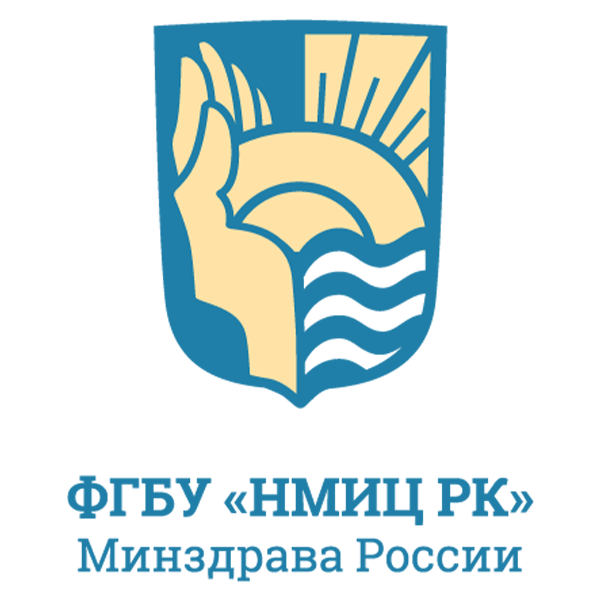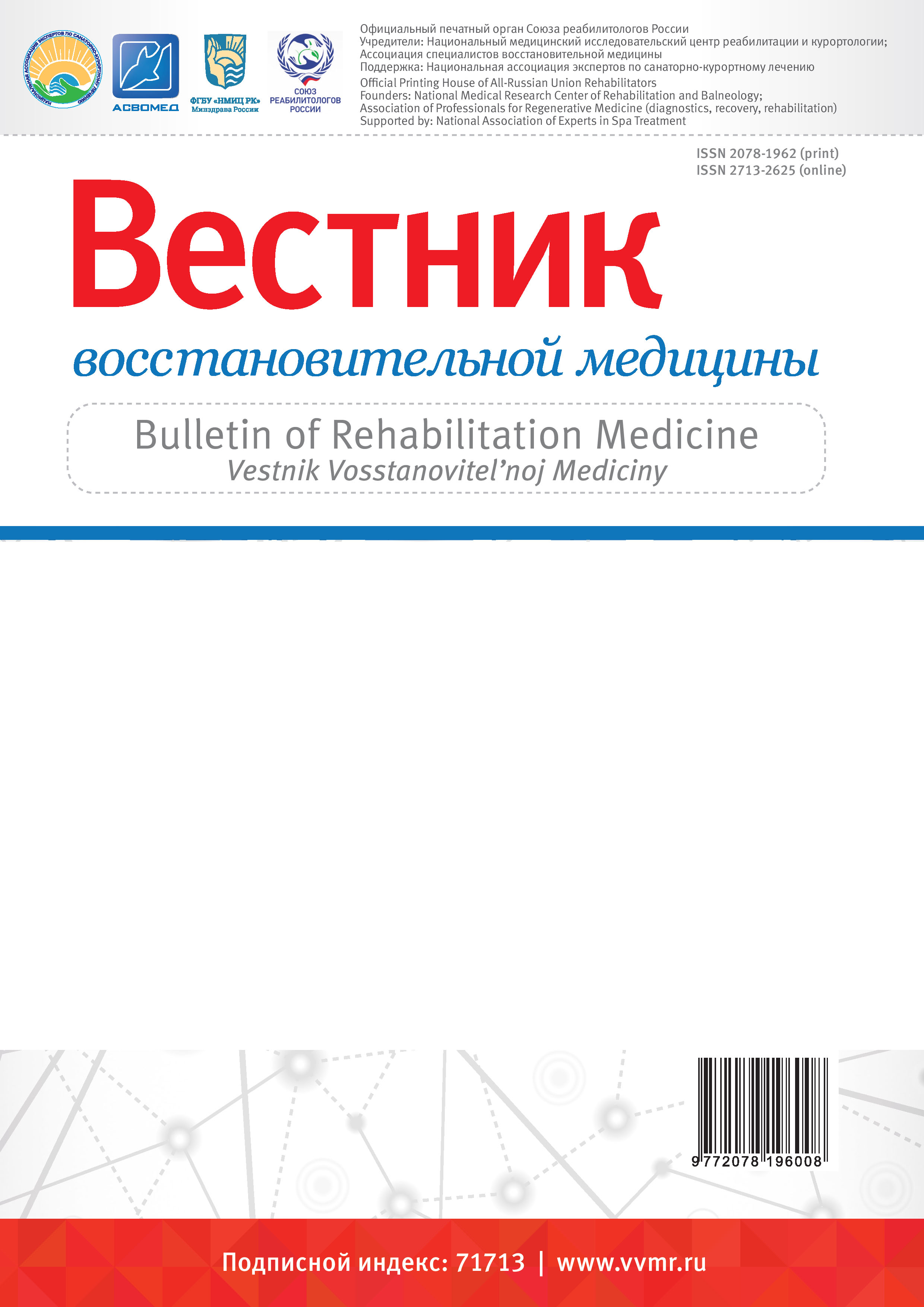Детская городская клиническая больница им. Н.Ф. Филатова Департамента здравоохранения города Москвы, Москва, Россия
INTRODUCTION. According to the Federal Statistical Observation of the Ministry of Health of the Russian Federation, perinatal Central Nervous System affections are one of the leading causes of childhood disability. The development and scientific substantiation of new non-drug technologies for medical rehabilitation of children with perinatal lesions of the Central Nervous System remains the main task. A promising technique is Vojta-therapy, a method based on the activation of motor reflexes due to irritation of certain areas on the child’s body. AIM. Scientific substantiation of the use of Vojta therapy in the medical rehabilitation of children with the consequences of perinatal Central Nervous System affections. MATERIAL AND METHODS. Clinical observations were performed in 110 children with perinatal Central Nervous System affections between the ages of 2 and 12 months. The comparison groups were formed depending on the nature of kinesiotherapy: the study group (n=55) – children who received Vojta therapy; the comparison group (n=55) – children who did not receive Vojta-therapy. We used clinical and neurological examination, INFANIB score, and SPSS 23.0 statistical analysis. RESULTS AND DISCUSSION Analysis of the clinical and neurological examination data after Vojta therapy revealed a statisticallyv significant increase in the overall motor activity of children. When the method was included in the rehabilitation of patients under the age of 4 months, the number of children with delayed reflex extinction decreased, at the age of 4-8 months, the appearance of coups and crawling was recorded, at the age of 8 months, the walking skill was formed in a timely manner. By the adjusted age of 1 year, patients receiving Vojta therapy were diagnosed with cerebral palsy 2 times less often than in the comparison group. CONCLUSION. The inclusion of Vojta therapy in the program of medical rehabilitation of children with the consequences of perinatal Central Nervous System affections contributed to the reduction of pathological motor activity, improvement of muscle tone and the formation of age-related skills. The use of Vojta therapy in children with the consequences of perinatal Central Nervous System affections up to 8 months determined a more pronounced increase in the grade score on the INFANIB scale and helped to reduce the frequency of cerebral palsy formation by 2 times.
non-drug technologies, perinatal central nervous system affection; perinatal hypoxic-ischemic encephalopathy, kinesiotherapy, bobath, Vojta therapy
1. Degtyareva M.G. Lednikovyy period Terapevticheskaya gipotermiya pri okazanii pomoschi donoshennym detyam, rozhdennym v tyazheloy asfiksii. StatusPraesens. Pediatriya i neonatologiya. 2018; 1(46): 71-80.
2. Karkashidze G.A., Anikin A.V., Zimina E.P., Davydova I.V., Karimova H.M., Zaharyan M.E., Namazova-Baranova L.S., Maslova O.I., Yacyk G.V., Valieva S.I., Gevorkyan A.K. Sovremennye dannye o patogeneze i lechenii gipokischeski-ishemicheskih porazheniy golovnogo mozga u novorozhdennyh. Pediatricheskaya farmakologiya. 2016; 13(5): 452-467. https://doi.org/10.15690/pf.v13i5.1641
3. Han M.A., Petrova M.S., Degtyareva M.G. Sovremennye tehnologii fizicheskoy reabilitaciya detey s perinatal'nym porazheniem central'noy nervnoy sistemy. Vestnik vosstanovitel'noy mediciny. 2021; 20(4): 57-64. https://doi.org/10.38025/2078-1962-2021-20-4-57-64
4. Dolotova N.V., Fil'kina O.M., Vorob'eva E.A., Kuz'menko G.N. Sostoyanie zdorov'ya i otdel'nye mehanizmy formirovaniya ego narusheniy u detey-invalidov v rezul'tate posledstviy perinatal'nyh porazheniy central'noy nervnoy sistemy v vozraste do 4 let. Lechenie i profilaktika. 2018; 8(1(25)): 13-18.
5. Leavy A., Jimenez Mateos E.M. Perinatal Brain Injury and Inflammation. Lessons from Experimental Murine Models. Cells. 2020; 9(12): 2640 p. https://doi.org/10.3390/cells9122640
6. De-La-Barrera-Aranda E., Gonzalez-Gerez J.J., Saavedra-Hernandez M., Fernandez-Bueno L., Rodriguez-Blanco C., Bernal-Utrera C. Vojta Therapy in Neuromotor Development of Pediatrics Patients with Periventricular Leukomalacia: Case Series. Medicina. 2021; 57(11): 1149 p. https://doi.org/10.3390/medicina57111149
7. Ha S.Y., Sung Y.H. Vojta Approach Affects Neck Stability and Static Balance in Sitting Position of Children with Hypotonia. International Neurourology Journal. 2021; 25(2): 90-95. https://doi.org/10.5213/inj.2142344.172
8. Tekin F., Kavlak E., Cavlak U., Altug F. Effectiveness of Neuro-Developmental Treatment (Bobath Concept) on postural control and balance in Cerebral Palsied children. Pamukkale University, School of Physical Therapy and Rehabilitation. 2018; 31(2): 397-403.
9. Sanz-Esteban I., Calvo-Lobo C., Ríos-Lago M., Álvarez-Linera J., Muñoz-García D., Rodríguez-Sanz D. Mapping the human brain during a specific Voj- ta’s tactile input: the ipsilateral putamen’s role. Medicine. 2018; 97(13): e0253 p. https://doi.org/10.1097/MD.0000000000010253
10. Semenova E.V., Klochkova E.V., Korshikova-Morozova A.E., Truhacheva A.V., Zablockis E.Yu. Reabilitaciya detey s DCP: obzor sovremennyh podhodov v pomosch' reabilitacionnym centram. Lepta Kniga. 2018: 584 s.






